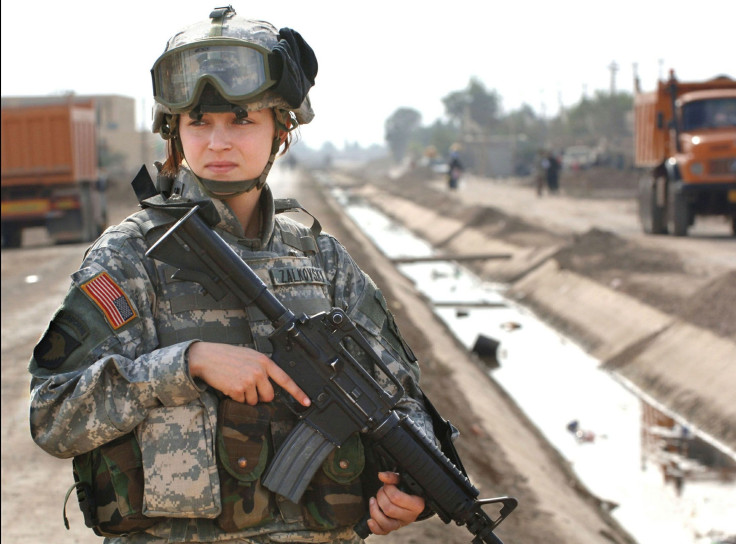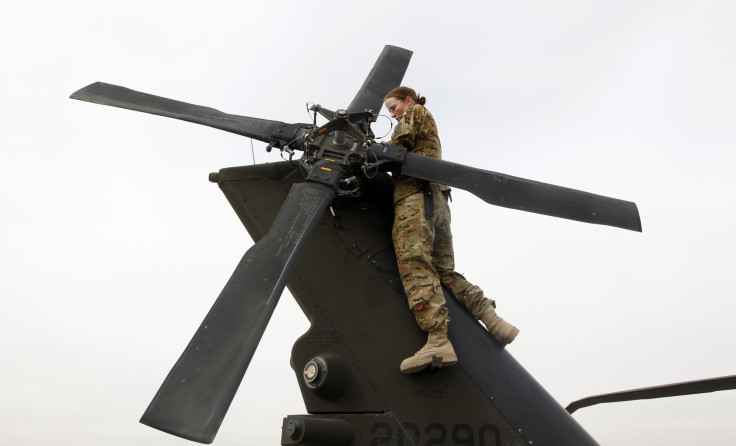Women In Combat: Now It's Official, But They Were Already Fighting

Stationed in the Iraqi city of Baiji, about 130 miles north of Baghdad, Army National Guard Sergeant Carolyn Schapper was an outlier: the only woman in a house with 20 men. But that didn’t mean a thing when it came to carrying out her assigned missions.
Schapper went on about 200 combat patrols during the year she was stationed in Iraq, from 2005 to 2006. Her vehicle was twice hit by improvised explosive devices, or IEDs. Mortars and rockets struck her army base several times.
“There was absolutely no difference between my duties and those of my male peers,” she said. “We went on the same missions, pulled the same security and drove the same vehicles.”
For many female veterans and active duty soldiers, Schapper’s experiences in Iraq will sound familiar. Women in the U.S. military have been putting their lives on the line for decades; they currently make up about 20 percent of the national armed forces. Of the approximately 280,000 females who have been deployed in Iraq and Afghanistan in the past 12 years, 152 have died and at least 800 have been wounded.
This week, the Department of Defense honored those sacrifices by making a decision that will advance gender equality in the U.S. armed forces: Women will no longer be barred from serving front-line combat roles.
“This issue has generated a lot of debate,” says Paul Rieckhoff, an Iraq War veteran and the Executive Director of Iraq and Afghanistan Veterans of America, or IAVA. “But the Joint Chiefs of Staff are unanimously behind this, and that says a lot. The military, more than any other organization I can think of, is good at adapting to change. If they’re told to do something, they’re going to do it.”
According to some, they’ve already done it. Female veterans can attest to the fact that the Pentagon’s order is more of a cosmetic change than an effective one, since so many women have already found themselves in the line of fire.
Making It Official
Secretary of Defense Leon Panetta and General Martin Dempsey, chairman of the Joint Chiefs of Staff, struck down the gender-based combat exclusion rule on Thursday. The two men sat side-by-side at a Pentagon ceremony to sign the order as cameras rolled.
But a change this significant cannot be accomplished with a pen stroke alone; delays and provisos are expected. Gender-neutral standards will have to be set out. Studies are to be conducted. Military officials may request exemptions until May 15, so it is quite possible that some elite combat positions will remain closed to women indefinitely.

The new rules -- and the expected setbacks in implementation -- were met with mixed reactions. Some, like former Army Sergeant Rebekah Havrilla, are happy with the change but note that the Pentagon is simply recognizing what was already happening on the ground.
Havrilla was deployed in Afghanistan from Sept. 2006 to Sept. 2007, where she was an Explosive Ordinance Disposal Technician.
“I took care of IEDs for a living,” she said. “I saw combat repeatedly. I went outside the wires six or seven days a week. I was in a couple of firefights; I was hit by IEDs multiple times. We spent days on end near the border with Pakistan engaged in missions. If that’s not a front-line experience, I don’t know what is.”
Schapper agrees. “Women go out with these front-line troops all the time. Their primary job is not to shoot, but they’re still in as much danger,” she said. “Responding to an attack, in a defensive posture, is still combat. If you are actively engaged by the enemy, you have been in combat.”
Not Everybody Agrees
But some are urging the Pentagon to reconsider its decision.
Mackubin Thomas Owens is a professor of national security at the U.S. Naval War College in R.I.; he is also a senior fellow at the Foreign Policy Research Institute and the editor of Orbis, a quarterly journal of international affairs.
Owens served 30 years of active duty and reserves for the U.S. Marine Corps and earned a Silver Star for his work as an infantry platoon commander in Vietnam during the 1960s. He knows from experience that women have done excellent work in military service for decades -- but for him, the termination of gender-based combat exclusion set off red flags.
“I don’t see the need for it,” he says. “Apparently, the impetus has to do with the idea of fairness, but there hasn’t been enough discussion about making the military more effective. Men and women are different; they’re not interchangeable. There are physical strength issues. And women and men interact differently, which can have an impact on unit cohesion.”
The male-female strength difference does not apply to all individuals, and there is debate as to whether it can be overcome with proper training -- that makes gender-based physical differences a very touchy subject. But there is no denying that strength becomes a serious issue the moment a soldier needs to carry a wounded comrade, or change a tire on a five-ton truck.
Owens also claims that gender differences on the battlefield can hurt team performance. “Part of the problem is that the possibility of sexual relations tends to skew things in close quarters,” he says.
The statement is backed up by some troubling trends. Defense Department research has shown that one out of three women in the armed forces has suffered a sexual assault; that’s twice the rate for American civilian women.
Military servicewomen also experience higher rates of unplanned pregnancies than their civilian counterparts, according to a recent study from Ibis Reproductive Health, a research and advocacy organization based in Massachusetts. Of all active duty women between the ages of 18 and 44, about 10.5 percent reported an unplanned pregnancy. Again, that’s about twice the rate for American civilian women.
It is clear that the U.S. military has a long way to go in order to address these issues. But Havrilla, the former sergeant who served in Afghanistan, thinks that more inclusion will help -- not hinder-- progress on that front.
“I think the more diversity we get in the military, the better chance we have for social change,” she said.
“The more women are involved, the more we’ll see harassment and sexual assault rates decrease over time. A lot of people are not happy about this, but diversity is beneficial for any organization.”
A Long Time Coming
When Dempsey and Panetta signed that order on Thursday, it was undoubtedly a momentous event. But taken in context, it is only one more step on a long road toward equality in the armed forces.
Few know that better than retired Brigadier General Pat Foote, who was commissioned to serve in the Women’s Army Corps, as it was then called, in 1959 and began active duty in 1960.
“I came in not really knowing I was on the cusp of history,” she said. “This was the cusp of the women’s movement, the start of the generation that revolted against the Vietnam War, the beginning of the voluntary force in the 1970s. That’s when the armed forces saw the need to employ more women in the military; without the draft, men were not volunteering in numbers sufficient enough to meet Army needs.”

Despite all the progress taking place around her, Foote frequently found herself without the resources she needed to perform her duties.
“I was in Vietnam in 1967,” she said. “The army sent me there without proper field attire: no weapons, no helmet, no training to help me defend my own unit. And Vietnam was my first real experience in having a combat zone 360 degrees around you.”
That description might sound familiar to the veterans who served four decades later in Iraq and Afghanistan, where the front lines were blurry at best.
“There are no front lines in this type of war, and women have been acting in forward roles,” says Rieckhoff of IAVA. “But there has still been a glass ceiling: Women can’t go to ranger school; women can’t go to Special Forces. The overall structure created a lack of opportunity for advancement.”
Foote points out that this glass ceiling is evident when you look at military leadership at the highest levels.
“You’ll see a lot of men who have worked their whole lives for the military, beginning with combat arms. There are high-ranking positions that do not require combat arms experience, but those are few and far between. To get to the pinnacle, you have to be seasoned as a combat arms officer.”
The Old Standard
The Pentagon is now working toward greater equality in the military structure, but it remains to be seen whether drastic changes are actually in order on the battlefield. Owens points out that many women do not aspire to front-line combat positions. “I just don’t see the doors being knocked down,” he says.
After all, the new change will not require women to sign up for combat roles -- it will only make the option available.
“Personally, I don’t know many women who actually want infantry jobs,” says Iraq veteran Schapper. “But I’m supposing the ones who do know what they’re in for will physically prepare themselves, or else they’d never attempt it.”
Those women who do want to engage in combat will have to pass rigorous physical tests, just as men do today. Foote argues that it’s a question of equal opportunity, and nothing more. If any woman cannot pass muster, she will be barred from combat -- just as men have always been.
“Will every woman qualify for infantry? Heavens, no!” she says. “Will every man? No. We just need to put the standards out there and let those who have the ability try for them.”
Havrilla, too, is adamant that equality of opportunity be upheld.
“The physical standards should be straight across the board,” she said. “If [a female soldier] meets the standards, then she can serve in that capacity. This isn’t about separating the standards; it’s about one standard for everybody.”
That could mean the front lines won’t look so different even after the Pentagon decision is fully implemented -- especially since many of the women who are capable of filling those roles have already done so, unofficially.
In any case, say proponents of the change, the formal recognition of women’s capabilities is long overdue.
“I’m very excited about this,” says Havrilla. “It wish it had happened a lot sooner -- while I was in service. But I am extremely happy that the policy changes are finally catching up with reality.”

© Copyright IBTimes 2025. All rights reserved.





















